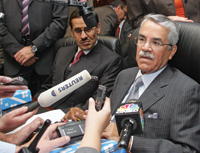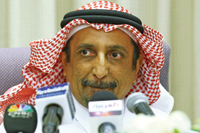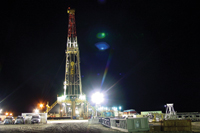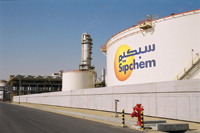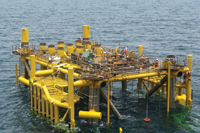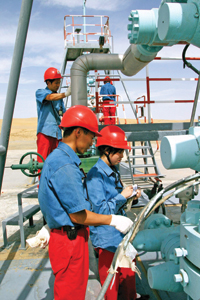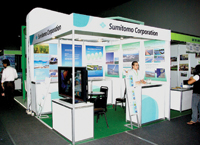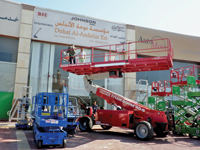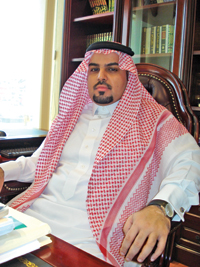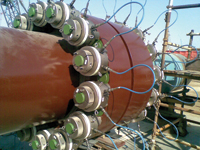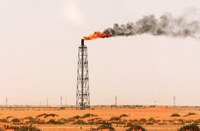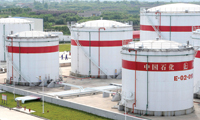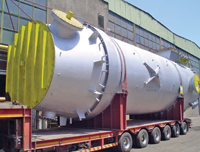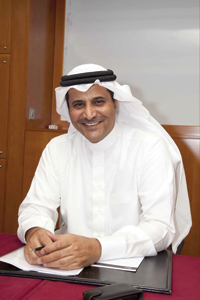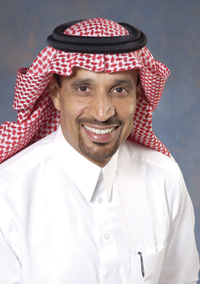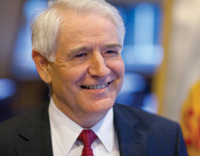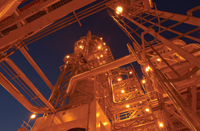
 Aramco ... adding to refining capacity
Aramco ... adding to refining capacity
SAUDI Arabia, the world’s largest crude exporter, is widening its global footprint planning to build refineries in China and Indonesia as part of a $200-billion spending programme to double refining capacity and exploring for oil and natural gas during the next decade.
Saudi Aramco, the kingdom’s national oil company is preparing for talks about the “final terms” for a Chinese refinery and is still waiting for “good terms to be put on the table” for a processing plant in Indonesia, CEO Khalid Al Falih says.
Aramco will probably decide soon whether to invest in expanding a plant it operates with Japan’s Sumitomo Chemical Company, he says. Aramco is expanding refining and petrochemical production to meet domestic demand and export refined products that can fetch higher prices than oil. The company plans to boost its global refining capacity to 8 million barrels per day (mbpd) in 10 years, including projects yet to be announced, Al Falih says. “It’s an aspiration for a longer-term growth objective,” he says of the refining-capacity target.
Aramco also plans to invest in drilling for oil and gas inside the kingdom and in petrochemicals production and other downstream activities, he says. The company is exploring for unconventional gas, including shale and tight gas, in the kingdom’s northwestern region, Al Falih says.
“Low gas prices are a challenge to developing these hard-to-reach deposits,” he says. Aramco’s capital spending will probably rise to more than $20 billion a year if it develops unconventional gas, he says.
Aramco will invest $90 billion in the next five years to increase refining capacity by 50 per cent to 6 mbpd in projects that more or less have been identified, Al Falih says.
Refining capacity in Saudi Arabia itself will rise to 3.46 mbpd in 2016 from 2.26 mbpd.
Most of the capacity to be added above the five-year target will be at refineries in Asia, with the bulk of that in China, Al Falih says. Aramco seeks to tap increasing consumption in China, Asia’s biggest energy user, by forming joint ventures with local partners.
The CEO says he is confident about reaching final terms on a plant with China National Petroleum Corp, that nation’s largest energy producer, to be built in southern Yunnan province. The companies have agreed on the scope of the project, including the refinery and marketing, he says.
“It’s always key for Saudi Aramco when we invest anywhere to consider both the refining side and the retail marketing network,” he says. A pipeline to transport crude to the refinery from neighbouring Myanmar will be completed in 2013, Al Falih says.
Aramco would ship Arabian Light and Arabian Medium crude grades under long-term contracts to Myanmar for onward transportation through the pipeline, he says. “In Indonesia, early indications are positive on Aramco’s plan to develop a refinery with state-run Pertamina,” Al Falih says.
The companies may build a 300,000 bpd refinery in Tuban in East Java. The $8.8-billion plant may start operating in 2018.
Aramco is meeting with Sumitomo Chemical to discuss where to go on the planned expansion of their jointly owned PetroRabigh refinery in Saudi Arabia. The partners missed their year-end target for deciding whether to invest $6-$8 billion to enlarge the facility.
Saudi Aramco is committed to make the expansion of Phase 2 of PetroRabigh happen and Al Falih says he’s confident that both companies will come to an agreement on the subject. Saudi Aramco might consider expanding the Ras Tanura refinery as a part of its plan to double refining capacity in 10 years, Al Falih says. The expansion involved a plant to process 400,000 bpd of Arabian Heavy crude though the company pushed this into the future after it decided to add a new local refinery with the same capacity in Jazan, in southern Saudi Arabia.
 |
|
Al Falih ... searching for |
Ras Tanura is Aramco’s largest local refinery with a capacity to refine 550,000 bpd. Aramco and Sinopec signed an agreement in January to develop a refinery in the Saudi city of Yanbu at a cost of as much as $10 billion. The 400,000 bpd plant will probably begin operating in 2014, Al Falih says. Sinopec, Aramco’s largest Chinese customer, agreed last March to take a 37.5 per cent stake in the Red Sea refinery, known as Yasref. The two companies are in early talks to add a new refinery in China that can process as much as 300,000 bpd, Al Falih says.
Along with the refinery expansion, Saudi Arabia is beginning an oil exploration push that it says is expected to turn up 100 billion barrels of new oil in existing fields in the kingdom and in unexplored regions including in the Red Sea.
The effort is also expected to increase the company’s natural gas production by 40 per cent by 2014.
Saudi Arabia has 267 billion of so-called proven reserves, about one-fifth of the world’s total. “Proven reserves” is an industry term that means oil or gas that has been discovered and could be produced with today’s technology. The world consumes about 89 mbpd, or 32.5 billion barrels per year. The industry describes a field as giant if it has 500 million barrels of oil or more.
Amir Nasser, a senior vice president in charge of exploration for Saudi Aramco says geological surveys suggest that the oil will be found in “frontier” areas in the kingdom, including in the shallow and deep waters of the Red Sea. Nasser said shallow water drilling has begun already and that deep water drilling will begin later this year.
“We are very optimistic about the potential for significant discoveries,” he says adding improved oil extraction techniques will allow the country to pull 70 per cent of the oil from its existing fields, up from 50 per cent.
The natural gas push is being made to handle strong growth in Saudi Arabian power demand. Nasser said power demand is rising 7 per cent a year.
Nasser says Saudi Aramco will improve its research and development capabilities by doubling the number of scientists who work for the company and opening research centers around the world. The first new research center will be in Houston, he said, though he did not say when it would be established.
Meanwhile, Saudi oil minister Ali Al Naimi says Saudi Arabia’s economy should not depend wholly on oil production and exports because of the volatility of the international market, and should instead develop new industries to support economic growth.
Naimi says Saudi Arabia would benefit from the expansion of its refining and petrochemical sectors.
“Oil, as we all know, is volatile in terms of prices and production rates,” Naimi says.
“For example, during the second half of 2008, prices dropped from $147/bbl to $35/bbl. At the same time, the kingdom’s production slowed from 9.5 mbpd to 8 mbpd,” Naimi says. “In light of such unpredictable fluctuations, it is not appropriate to depend on the production and export of oil as a basis for national income and sustainable economic development; rather, we should depend on oil revenues, products and various usages to create other sources of economic growth and prosperity on sound commercial bases.”
Naimi says that although Saudi Arabia produces “numerous” raw materials such as oil, gas, petrochemicals and minerals, that has not been accompanied by an increase in the production of related secondary and finished products.
Diversification into petrochemicals has become a cornerstone of the Saudi state oil company’s strategy since Al Falih was appointed chief executive in November 2008.
A new wave of aromatics investments is under discussion in Saudi Arabia. As part of a move further into petrochemicals, state-owned Saudi Aramco is building refineries with downstream aromatics production, as well as exploring ways to add aromatics at its existing refineries.
Until now, Aramco’s refineries have only produced oil products. “For the first time, Saudi Aramco is deciding to include petrochemicals units in its refinery projects,” says Paul Hodges, chairman of UK-based International eChem. “This is moving Saudi Arabia towards more of a European/Asian/US model of petrochemicals production.”
Aramco’s first large-scale aromatics facility will be located at a joint-venture refinery and petrochemicals complex it is building with France’s Total in Al-Jubail. Named Saudi Aramco Total Refining and Petrochemical (Satorp), the project will have paraxylene (PX) and benzene capacities of 700,000 tonnes per year (tpy) and 140,000 tpy respectively, and is scheduled to begin operations in the second half of 2013.
Aramco also plans to include aromatics production at refineries in Ras Tanura and Jazan, and is studying an aromatics project linked to its refinery activities in Yanbu, on the Red Sea coast.
As well as building aromatics units at refineries, Aramco is developing a petrochemicals project with US major Dow Chemical, named Sadara Chemical, and is planning an expansion at its existing Rabigh Refining and Petrochemical (PetroRabigh) joint venture with Japan’s Sumitomo Chemical. Aromatics are expected to be included in both projects.
 |
|
Sadara ... joint venture with Dow Chemicals |
Historically, most petrochemical producers in the Middle East have focused on gas-based production to exploit the region’s cost-advantaged ethane. Only Iran has followed more of a Western model of petrochemicals production by taking naphtha out of refineries. Much of Iran’s aromatics production, however, is often diverted into gasoline, Hodges notes.
In the UAE, aromatics investments have been proposed as part of potential major new projects, such as Chemaweyaat, but nothing has been finalised. Under the original plans, Chemaweyaat was considering building an 860,000 tpy benzene unit and a 1.4 mtpy PX unit. For Aramco, partnerships with foreign players in its refinery and petrochemicals investments are providing it with the technologies and market experience it needs for its push into petrochemicals.
Al Falih says the company is well positioned to maximise long-term value creation from its integrated activities “from the wellhead to the gas pump, and to the manufacturing of value-adding fibres, polymers, rubbers and plastics.”
He adds that Aramco, which will be a $60 billion business following the completion of the Sadara project, intends to become a “top-three petrochemical company.”
Saudi Arabia’s new aromatics production would be converted into downstream products, and then exported. Moving further downstream into new petrochemicals derivatives and end-products is part of the government’s strategy to create new jobs for the country. Two-thirds of the Saudi population is aged under 30, and youth unemployment is estimated at about three times the national average.
“Until now, there has been no rationale for investing in aromatics in Saudi Arabia, because you’ve got an engineering cost to think about, you can already sell the naphtha feedstock on a world market at a world market price and you have a freight cost to get the material to market,” says one foreign observer.



































































